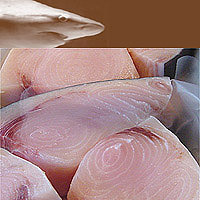Gluten Free
What does following a gluten-free diet mean? That you're embarking on an easy diet with a wide range of health-promoting effects. Instead of dwelling on what you’re giving up, consider that you’re going to enjoy a whole new world of delicious food options to meet your special dietary needs. You’ll be eating seasonally, choosing more fresh fruits and vegetables, focusing on meats, seafood, poultry, legumes, lentils, corn, and rice, and discovering fascinating ancient grains such as quinoa, amaranth, and millet. You’ll be able to eat potatoes, eggs, most cheeses, even chocolate (!)—and enjoy them without guilt because you’ll be taking good care of your body. In fact, you’ll probably end up eating—and feeling—better than ever!
Visit this page for more information about living Gluten Free
---
We carry a large variety of gluten free items, the brands listed below represent just some of the offerings we carry















More Diets
Shark

Preparation, Uses, & Tips
Sharks must be bled immediately after they are caught, or the meat takes on an ammonia taste. Most shark is properly treated. A slight ammonia smell can be eliminated by soaking the meat in buttermilk or lemon juice for 30 minutes.
Cut out any dark meat before cooking shark. Leave any skin attached, as it helps retain moisture during cooking.
The secret to successful shark cookery is do not overcook. Whichever of the following cooking methods you choose, your shark will be cooked when its flesh becomes opaque, yet is still moist on the inside.
Baking
Place shark in a greased baking dish, or wrap in oiled foil and place on a baking sheet. Brush with melted butter or oil and season with salt and pepper, or cover with a piquant sauce. Bake in a preheated 450°F (230°C) oven until done, about 10 minutes per inch (2.5cm) of thickness.
Grilling
Place fillets or steak chunks on skewers directly on a greased grill, 4 to 6 inches (about 10 to 15cm) above prepared coals or fire. Baste with butter, oil, or marinade. Cook until opaque and moist on the inside, 6 to 8 minutes.
Broiling
Place fillets skin-side-down on a well-greased baking pan. Pour in enough stock to cover the bottom of the pan. Brush top of fish with butter or oil. Broil under preheated broiler 4 to 5 inches (10 to 12cm) from heat. Do not turn, but baste several times. Cook until opaque and moist on the inside, 6 to 10 minutes.
Pan frying
Fry shark in a small amount of hot butter or oil, turning once halfway through cooking time. Cook until opaque and moist on the inside, 4 to 8 minutes.
Stir-frying
Cut shark steaks or fillets into bite-sized pieces. Coat with cornstarch and stir-fry gently and briefly in hot oil before adding to your favorite stir-fried vegetables.
Poaching
Bring poaching liquid, consisting of water, broth, and herbs and spices, to a simmer. Slip shark in, then cover pan and keep liquid at a simmer for about 8 minutes per inch (about 2.5cm) of thickness.
Steaming
Place shark on a greased perforated rack over 1 to 2 inches (2.5 to 5cm) of rapidly boiling water. Cover with a tight-fitting lid and keep water at a constant boil through cooking time, 8 to 10 minutes per inch (2.5cm) of thickness of the fish.
Copyright © 2025 TraceGains, Inc. All rights reserved.
Learn more about TraceGains, the company.
The information presented in the Food Guide is for informational purposes only and was created by a team of US–registered dietitians and food experts. Consult your doctor, practitioner, and/or pharmacist for any health problem and before using any supplements, making dietary changes, or before making any changes in prescribed medications. Information expires December 2025.











